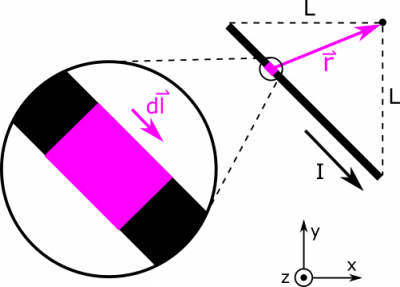This is an old revision of the document!
Using the Earth's Magnetic Field for Measurements
You have spotted an unidentified flying object! Naturally, you wish to find its charge. You have a compass, a good sense of direction, and keen eyesight. You notice that it is flying due south on a course that will pass directly overhead, and it is $30 \text{ m}$ above you, travelling at $200 \text{ m/s}$. You observe the dial on your properly aligned compass as the object passes overhead. As a function of time, this is what you see:
Facts
- We know $|\vec{B}_{\text{earth}}| = 32 \mu\text{T}$.
- If we align our coordinate axes, according to the represention below, $\vec{B}_{\text{earth}} = 32 \mu\text{T } \hat{y}$.
- $h = 30 \text{ m}$.
- $\vec{v} = -200 \text{ m/s } \hat{y}$.
- You have the graph of $\theta$ versus $t$.
Lacking
- $\vec{B}_{text{UFO}}$
Approximations & Assumptions
- The UFO can be approximated as a moving point charge.
- $q$, $\vec{v}$, $h$, and $\vec{B}_{\text{earth}}$ are all constants.
- Your sense of direction and eyesight can be trusted.
Representations
- We represent the Biot-Savart Law for the magnetic field from a moving point charge as
$$\vec{B}= \frac{\mu_0}{4 \pi}\frac{q \vec{v}\times \vec{r}}{r^3}$$
- We represent the situation with the following pictures. Coordinate axes and cardinal directions are specified.
Solution
Below, we show a diagram with a lot of pieces of the Biot-Savart Law unpacked. We show an example $\text{d}\vec{l}$, and a separation vector $\vec{r}$. Notice that $\text{d}\vec{l}$ is directed along the segment, in the same direction as the current. The separation vector $\vec{r}$ points as always from source to observation.
For now, we write $$\text{d}\vec{l} = \langle \text{d}x, \text{d}y, 0 \rangle$$ and $$\vec{r} = \vec{r}_{obs} - \vec{r}_{source} = 0 - \langle x, y, 0 \rangle = \langle -x, -y, 0 \rangle$$ Notice that we can rewrite $y$ as $y=-L-x$. This is a little tricky to arrive at, but is necessary to figure out unless you rotate your coordinate axes, which would be an alternative solution to this example. If finding $y$ is troublesome, it may be helpful to rotate. We can take the derivative of both sides to find $\text{d}y=-\text{d}x$. We can now plug in to express $\text{d}\vec{l}$ and $\vec{r}$ in terms of $x$ and $\text{d}x$: $$\text{d}\vec{l} = \langle \text{d}x, -\text{d}x, 0 \rangle$$ $$\vec{r} = \langle -x, L+x, 0 \rangle$$ Now, a couple other quantities that we see will be useful: $$\text{d}\vec{l} \times \vec{r} = \langle 0, 0, \text{d}x(L+x) - (-\text{d}x)(-x) \rangle = \langle 0, 0, L\text{d}x \rangle = L\text{d}x \hat{z}$$ $$r^3 = (x^2 + (L+x)^2)^{3/2}$$ The last thing we need is the bounds on our integral. Our variable of integration is $x$, since we chose to express everything in terms of $x$ and $\text{d}x$. Our segment begins at $x=-L$, and ends at $x=0$, so these will be the limits on our integral. Below, we write the integral all set up, and then we evaluate using some assistance some Wolfram Alpha. \begin{align*} \vec{B} &= \int \frac{\mu_0}{4 \pi}\frac{I \cdot d\vec{l}\times \vec{r}}{r^3} \\ &= \int_{-L}^0 \frac{\mu_0}{4 \pi}\frac{IL\text{d}x}{(x^2 + (L+x)^2)^{3/2}}\hat{z} \\ &= \frac{\mu_0}{2 \pi}\frac{I}{L}\hat{z} \end{align*}

